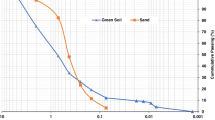Abstract
To explore the stabilization effect of stabilizing agent GX07 on treating organic soil and the influence of organic matter on the strength development of stabilized soil, artificial organic soil with various organic matter content was obtained by adding different amounts of fulvic acid into non-organic clay, and then liquid-plastic limit tests were carried out on the artificial organic soil. Meanwhile, unconfined compressive strength (UCS) tests were performed on cement-only soil and composite stabilized soil, respectively. The test results indicate that the plastic limit of soil samples increases linearly, and the liquid limit increases exponentially as the organic matter content increases. The strength of stabilized soil is well correlated with the organic matter content, cement content, stabilizing agent content and curing time. When the organic matter content is 6%, as the cement content varies in the range of 10%–20%, the strength of cement-only soil increases from 88.5 to 280.8 kPa. Once 12.6% GX07 is added into the mix, the strength of stabilized soil is 4.93 times compared with that of cement-only soil. GX07 can obviously improve the strength of cemented-soil and has a good economic applicability. A strength model is proposed to predict strength development.
Similar content being viewed by others
References
HORPIBULSUK S, RACHAN R, SUDDEEPONG A. Assessment of strength development in blended cement admixed Bangkok clay [J]. Construction and Building Materials, 2011, 25: 1521–1531.
HORPIBULSUK S, SHIBUYA S, FUENKAJORN K, KATKAN W. Assessment of engineering properties of Bangkok clay [J]. Can Geotech, 2007, 44: 173–187.
AZUMA K, OHISHI K, ISHIII T. Application of FGC deep mixing to the brace excavation [C]// Proceedings of Soft Ground Engineering in Coastal Areas. Leiden, 2003: 223–232.
HUGHES P, GLENDINNING S. Deep dry mix ground improvement of soft peaty clay using blast furnace slag and red gypsum [J]. Quarterly Journal of Engineering Geology and Hydrogeology, 2004, 37: 205–216.
THONGCHAI A, PIMRAKSA K. The uses of waste gypsum in stabilizing wet soft soils [C]// Proceedings of Geo-Changsha 2007: an International Conference on Geotechnical Engineering. Singapore, 2007: 335–342.
HORPIBULSUK S, RACHAN R, CHINKULKIJINIWAT A, RAKSACHON Y, SUDDEEPONG A. Analysis of strength development in cement-stabilized silty clay based on microstructural considerations [J]. Constr Build Mater, 2010, 24: 2011–2022.
LEE F, LEE Y, CHEW S, YONG K. Strength and modulus of marine clay-cement mixes [J]. Journal of Geotechnical and Geoenvionmental Engineering, 2005, 131(2): 178–186.
HORPIBULSUK S, MIURA N, NAGARAJ T S. Assessment of strength development in cement-admixed high water content clays with Abrams’law as a basis [J]. Geotechnique, 2003, 53(4): 439–444.
CHU Cheng-fu, HONG Zhen-shun, LIU Song-yu, XU Ting. Unconfined compressive strength of cemented soils with quasi-water-cement ratio [J]. Rock and Soil Mechanics, 2005, 26(4): 645–649.
ZHANG Tie-jun, HONG Zhen-shun, DENG Dong-sheng, DENG Yong-feng, DING Jian-wen. Predication method of unconfined compression strength for cemented silty soils [J]. Journal of Southeast University: Natural Science Edition, 2008, 38(5): 829–843.
CHEN Hui-e, WANG Qing. The behavior of organic matter in the process of soft soil stabilization using cement [J]. Bulletin of Engineering Geology and the Environment, 2006 (65): 445–448.
BUSH W H, KELLER G H. The physical properties of Peru-Chile continental margin sediments-the influence of coastal upwelling on sediment properties [J]. Journal of Sedimentary Petrology, 1981, 51: 705–719.
XU Ri-qing, GUO Yin, SHAO Yu-fang, LIU Zeng-yong. A kind of composite stabilizing agent on muddy soil: China, ZL200710070010.2 [P]. 2010.
XU Ri-qing, GUO Yin, LIU Zeng-yong. Experimental study on mechanical properties of stabilized artificial organic soil [J]. Journal of Zhejiang University, 2007, 41(1): 109–113.
GUO Yin, XU Ri-qing, SHAO Yun-cheng. Study on mechanism of muddy soil stabilization [J]. Journal of Zhejiang University, 2008, 42(6): 1071–1075.
NARENDRA B, SIVAPULLAIAH P, SURESH S, OMKAR S. Prediction of unconfined compressive strength of soft grounds using computational intelligence techniques: A comparative study [J]. Computers and Geotechnics, 2006, 33(3): 196–208.
HARVEY R, HARRIS P, HERBERT E, STIFFLER A, HANEY P. Natural organic matter and the formation of calcium-silicate-hydrates in lime-stabilized smectites: A thermal analysis study [J]. Thermochimica Acta, 2010, 505(1/2): 106–113.
Author information
Authors and Affiliations
Corresponding author
Additional information
Foundation item: Project(50678158) supported by the National Natural Science Foundation of China
Rights and permissions
About this article
Cite this article
Li, Xg., Xu, Rq. & Rong, Xn. Assessment of strength development in cement-admixed artificial organic soil with GX07. J. Cent. South Univ. 19, 2999–3005 (2012). https://doi.org/10.1007/s11771-012-1369-7
Received:
Accepted:
Published:
Issue Date:
DOI: https://doi.org/10.1007/s11771-012-1369-7




